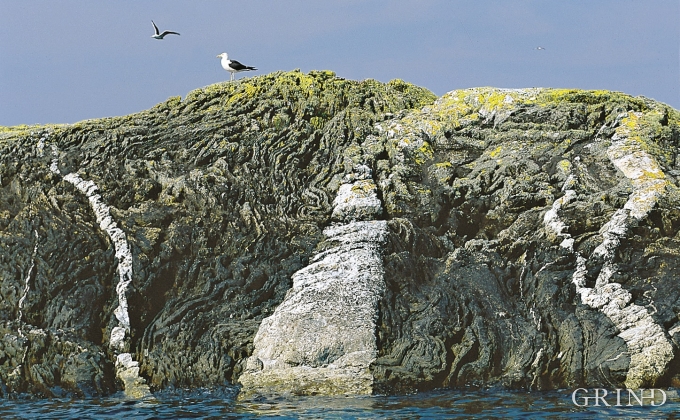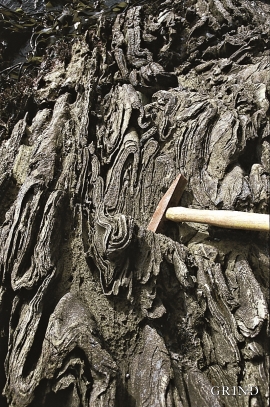Published: 28.07.2015 | Author: Haakon Fossen, Erling Rykkelid
Skerries with a long history - white veins of granite that have intruded into the folded calcium silicate bedrock. (Helge Haukeland)
GEOLOGY WASHED CLEAN
The sea keeps the bedrock in the outer skerries smooth and clean. When the bedrock is also varied and interesting, the setting is perfect for a discovery tour of these bare-faced outcrops.
In the Møkster- and Selbjorn areas, one finds the remains of both a roughly 490 million-year old oceanic crust and deposits on top of this crust. The oceanic crust itself, which consists mainly of gabbro and greenstone schist, is only visible on the small islands and islets between Lunnøya Island and Selbjørn. The deposits on top of the crust are preserved on Selbjørn and on other islands in the area, for example, on Litla Kalsøy. These stand out as alternating bands of calcium-silicate and marble. Originally, they were laid down on top of the crust as layer upon layer of clay and limestone.
The calcium-silicate layer is metamorphosed mudstone. Some of the original clay layers, that were later altered to claystone and calcium-silicate, were unusually rich in the element boron, a material that is found in areas with underground volcanism. When gabbro and granite intruded in and partially melted the mudstones, large and magnificent crystals of the boron-rich mineral tourmaline formed. The tourmaline crystals are totally black, because of their high iron content. These crystals are found in a number of granite veins in the area.
The pattern in the calcium-silicate bedrocks can be quite special and decorative. It is easy to polish and can be treated with acid, if one wants a decorative stone from this area.
The marble was formed when the shells from thousands of tiny organisms that once lived on the seafloor during the Ordovician Period became cemented together over time. The finest and purest marble is found at Salthella, where there has also been a marble quarry. At other places the marble can have a rusty surface because of the mineral graphite. The graphite is an alteration product from coal and oil, which also comes from the animals that lived inside of the calcite shells. There was probably also oil in the bedrock at Austevoll at some time in the past.
- Fossen, H.; Dunlap, W. J.,1999. On the age and tectonic significance of Permo-Triassic dikes in the Bergen-Sunnhordland region, southwestern Norway. Norsk Geologisk Tidsskrift, 79:169–178.
- Færseth, R. B., Macintyre, R. M.; Naterstad, J., 1976.Mesozoic alkaline dykes in the Sunnhordland region, western Norway: ages, geochemistry and regional significance. Lithos 9:331–345.
- Færseth, R. B.,1978. Mantle-derived lherzolite xenoliths and megacrysts from Permo-Triassic dykes, Sunnhordland, western Norway. Lithos 11:23–35.
- Rykkelid, E. Geologisk utvikling i Møkster (Selbjørnområdet) i Sunnhordland. Cand.scient.avhandl.,UiB,1987.





